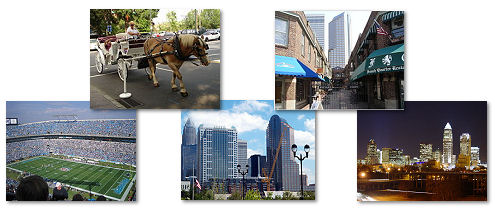
City Maps/Weather
| Fun City Facts The Rockville Bridge, the longest stone arch bridge in the world, is in Harrisburg, Pennsylvania. The top of the Empire State Building in New York was buit to be a mooring place for dirigibles (Blimps). |
|
|
||||||||
Charlotte, North Carolina
City History |
||||||||
 The area that is now Charlotte was first settled in 1755 when Thomas Polk (uncle of United States President James K. Polk), traveling with Thomas Spratt and his family, stopped and built his house at the intersection of two Native American trading paths between the Yadkin and Catawba rivers. In the early part of the 18th century, the Great Wagon Road led settlers here from Pennsylvania into the Carolina foothills. Within the decades following Polk's settling, the area grew to become the community of "Charlotte Town." Both the town and its county are named for Charlotte of Mecklenburg-Strelitz, the German-born wife of British King George III. The town name was chosen in hopes of winning favor with the crown, but tensions between the United Kingdom and Charlotte Town began to grow as King George imposed unpopular laws on the citizens in response to the townspeople's desire for independence. On May 20, 1775, the townsmen allegedly signed a proclamation later known as the Mecklenburg Declaration of Independence, a copy of which was sent, though never officially presented, to the Continental Congress a year later. Eleven days later, the same townsmen met to create and endorse the Mecklenburg Resolves, a set of laws to govern the newly independent town. Charlotte was a site of encampment for both American and British armies during the Revolutionary War, and during a series of skirmishes between British troops and Charlotteans the village earned the lasting nickname "Hornet's Nest" from frustrated Lord General Charles Cornwallis. Churches, mainly of the Presbyterian faith, but also Baptists, Methodists, Episcopalians, Lutherans and Catholics began to form in the early 1800s, eventually giving Charlotte its nickname "The City of Churches." In 1799, 12 year-old Conrad Reed brought home a rock weighing about 17 pounds, which the family used as a bulky doorstop for three years before it was recognized by a jeweler as near solid gold and bought for a paltry $3.50. The first verified gold-find in the fledgling United States, young Reed's discovery became the genesis of the nation's first gold rush. Many veins of gold were found in the area throughout the 1800s and even into the early 1900s, thus the founding of the Charlotte Mint in 1837 for minting local gold. The state of North Carolina "led the nation in gold production until the California Gold Rush of 1848. The Charlotte Mint was active until 1861, when Confederate forces seized the mint at the outbreak of the Civil War. The mint was not reopened at the end of the war. The city's first boom came after the Civil War, as a cotton processing center and a railroad hub. Population leapt again during World War I, when the U.S. government established Camp Greene north of present-day Wilkinson Boulevard. Today the city's modern-day banking industry achieved prominence in the 1970s and 1980s, largely under the leadership of financier Hugh McColl. Today, Charlotte is the second largest banking headquarters in the United States after New York City. |
Historic Figures
John Bell Hood (1831-1879)| John Bell Hood (1831-1879) | |
| John Bell Hood was a Confederate general during the American Civil War. Hood had a reputation for bravery and aggressiveness that sometimes bordered on recklessness. Arguably one of the best brigade and division commanders in the Confederate States Army, Hood became increasingly ineffective as he was promoted to lead larger, independent commands, and his career was marred by his decisive defeats leading an army in the Atlanta Campaign and the Franklin-Nashville Campaign. | |
browse cities | search | get listed | spotlight | about us | contact us | policies | partners
Copyright ©2024 www.ByCityLight.com - Page Design by Erik Schubach and Tristan Chambers